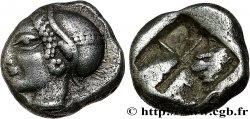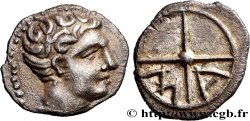v34_1172 - MASSALIA - MARSEILLE Litra à la tête casquée à gauche
MONNAIES 34 (2008)
Starting price : 150.00 €
Estimate : 250.00 €
unsold lot
Starting price : 150.00 €
Estimate : 250.00 €
unsold lot
Type : Litra à la tête casquée à gauche
Date: c. 450-410 AC.
Mint name / Town : Marseille (13)
Metal : silver
Diameter : 10 mm
Weight : 0,93 g.
Rarity : R3
Coments on the condition:
Droit complet, bien ajusté au flan, mais un peu mou. Revers complet avec une cassure sur le bord extérieur de la roue. Fine patine irisée et jaunâtre, surtout au revers
Catalogue references :
Obverse
Obverse legend : ANÉPIGRAPHE.
Obverse description : Tête casquée à gauche, timbrée d'une roue à quatre rayons.
Reverse
Reverse legend : ANÉPIGRAPHE.
Reverse description : Roue à quatre rayons avec moyeu central évidé, entretoisée sur la jante.
Commentary
Ce type de litra existe avec la tête à droite ou avec la tête à gauche. Le revers est particulier avec des entretoises pleines contre la jante de la roue. Ce type de revers correspond aux n° 55-58 du trésor de monnaies massaliètes du Ve siècle, RN. 1983.
Exemplaire de poids relativement lourd malgré une usure ou un droit frappé avec un coin usé.
Exemplaire de poids relativement lourd malgré une usure ou un droit frappé avec un coin usé.








 Report a mistake
Report a mistake Print the page
Print the page Share my selection
Share my selection Ask a question
Ask a question Consign / sell
Consign / sell
 Full data
Full data



